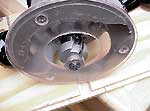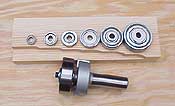www.finewoodworking.com/SkillsAndTechniques
How to Route a Rabbet Joint
How to Cut Rabbet Joints
- Determine the depth and width to cut for the rabbet joint. Since it is a L-shaped joint, you need to figure in the size for the corresponding side of the connecting piece of wood. Don't remove more than half of the width of the wood.
- Set up your router. If you don't have the exact size bit, use a smaller bit and make two passes. Remember to keep the router unplugged whenever you change bits.
- Use a router bearing to give you more flexibility in choosing the depth and width of a rabbet joint. These bearings come in different sizes and make adjustments a lot easier.
- Router the rabbet joint on a piece of scrap wood. It's a matter of listening to your machine to know if you're going at the correct speed. If you go too quickly, the wood can splinter. If you go too slowly, the wood can burn. At the correct speed, the wood gets shaved away and the router sounds like it's working.
- Cut the good wood when you have the practice rabbet joint correct. Finish the joint by gluing, nailing or screwing the two pieces together.
===============================
popularwoodworking.com/article/cut-accurate-and-clean-rabbets (the best methode!)
=====================
Rabbet Joints and "Adjustable" Bits
 |
Using
a hand-held router and rabbeting bit can be easier, faster and safer
than rabbeting on a table saw. Perhaps cheaper as well!
Click image to enlarge |
Accurate, fast, simple and safeText and photos by Tom Hintz
Note: Always unplug the router whenever working with or around router bits. Eliminating the power source is the only way to insure safety when performing these tasks!
Rabbets are one of the first joints new woodworkers learn, and then never stop using. Rabbets are easy to make with common tools, and are effective in many situations.Though rabbets can be cut with many different power tools and equipment, for many woodworkers, the hand-held router is the tool of choice, in part because it is already in their shop.
When to Rabbet
Rabbet joints are relatively strong and certainly have their place in modern woodworking. However, even when bolstered by the superior holding characteristics of the modern adhesives we use, a rabbet joint is not as strong as dovetails or mortise and tenons.
In light-load situations, such as a small drawer, rabbets may be sufficient. Dovetails would be more appropriate for a larger drawer, or one expected to see frequent use like in the kitchen.
You get to decide which joint to use on your projects. However, remember that you are also the one who will answer the questions if there is a failure.
Time and Space
Even when a table saw and dado set is available, rabbeting with a router may be faster and easier. Using a router can eliminate having to disturb the setup of another machine that may still be needed for the project. In most cases, the quality of rabbets produced by a router are at least equal to those made with other machines.
When rabbets have to be cut in long pieces of wood, running them across the
 |
Infinity's Bearing Kit makes one bit capable of all these cut widths, plus lets you use the bit for flush trim work as well.
Click image to enlarge |
Versatility Through Bearings
Infinity Bearing/Cut-Width
|
|
Bearing Diameter
|
Cut-Width
|
1/2"
|
7/16"
|
5/8"
|
3/8"
|
3/4"
|
5/16"
|
7/8"
|
1/4"
|
1 1/8"
|
1/8"
|
1 3/8"
|
Flush Trim
|
In producing this story, I used the Infinity Cutting Tools Rabbet Bit (#35-850) and their Bearing Kit (#RB-155). The Infinity rabbeting bit came equipped with a 3/8"-diameter bearing that produces a ½" cut width. The Infinity Bearing Kit includes six bearings in various sizes that produce cut widths from 7/16" to 0. Installing the largest bearing converts the rabbeting bit into a flush-trim bit. (See the chart)
Another useful feature of changeable bearings is the speed with which cutter width can be changed. Unplug the router, remove an Allen screw, replace the bearing with the diameter wanted and replace the screw. In most cases, the bit never has to be removed from the (unplugged) router.
Speed and Feed
Rabbeting bits are rather large in diameter, which makes router speed (rpm) a consideration. The Infinity Rabbeting Bit is 1 3/8" in diameter and has a recommended rpm limit of 18,000 rpm. It is important for safety and performance to follow the recommendations of the bit and router manufacturers regarding router speed and the size of bit being used. If your router does not have a variable speed control, check the documentation that came with it for its operating rpm (usually listed on a plate on the router itself also) to see if it is compatible with the bit you are using.
How fast we move the router along the wood directly affects the quality of the cut produced. Move too quickly and splintering or tear out can result. Moving the router too slowly may cause burning of the wood.
Finding the proper feed rate is often a combination of feel and sound. If you are getting a clean cut with no burning or tear out, your feed rate is probably correct. The router should sound like it is "working" somewhat, not freewheeling at maximum rpm or bogging down from excessive loading.
Setting Depth
Note: Removing too much wood in one pass is a sure way to mess up any cutting operation. Cutting rabbets is no exception. If a rabbet cut is larger than ¼" by ¼," especially in hardwood, making multiple passes taking lighter cuts will be safer and more productive. It takes a little longer but the quality of the cuts is more than worth the effort.
A common rabbeting job is creating a recess in the rear of cabinet sides in which to conceal the end grain of the back panel. Since it is easiest to make this cut with the cabinet side laying flat on a table, we have to remember that in this position, the bearing controls the depth of the recess and the amount of bit exposed below the routers base regulates what will be the width.When deciding how deep into a piece of wood to cut a rabbet, it is important to consider how much wood will remain after the cut. Removing more than half of the thickness can weaken rather than strengthen the joint. The most common rabbet depth is approximately 1/3rd of the thickness of the wood into which it is cut.
Many times, it is best to cut rabbets slightly deeper than necessary to make sanding the joint smooth easier. In the case of a rabbet in the back of a cabinet, making the cut 1/16" deeper than the panel thickness insures all of the end grain is concealed.
There are times when it is necessary to use the router with its base on the edge of a board. Trying to balance a router on such a narrow surface is difficult to say the least. Screwing a wide piece of wood to a router fence helps. To learn more about another alternative to this procedure see "Routing on the Edge" in the Tips & Tricks section of this site.
If there is a constant in woodworking, it is that situations always change. Regardless of the size of our power tool inventory, having a good rabbeting bit for your hand-held router means you will be prepared for more of the situations encountered in your shop.


No comments:
Post a Comment